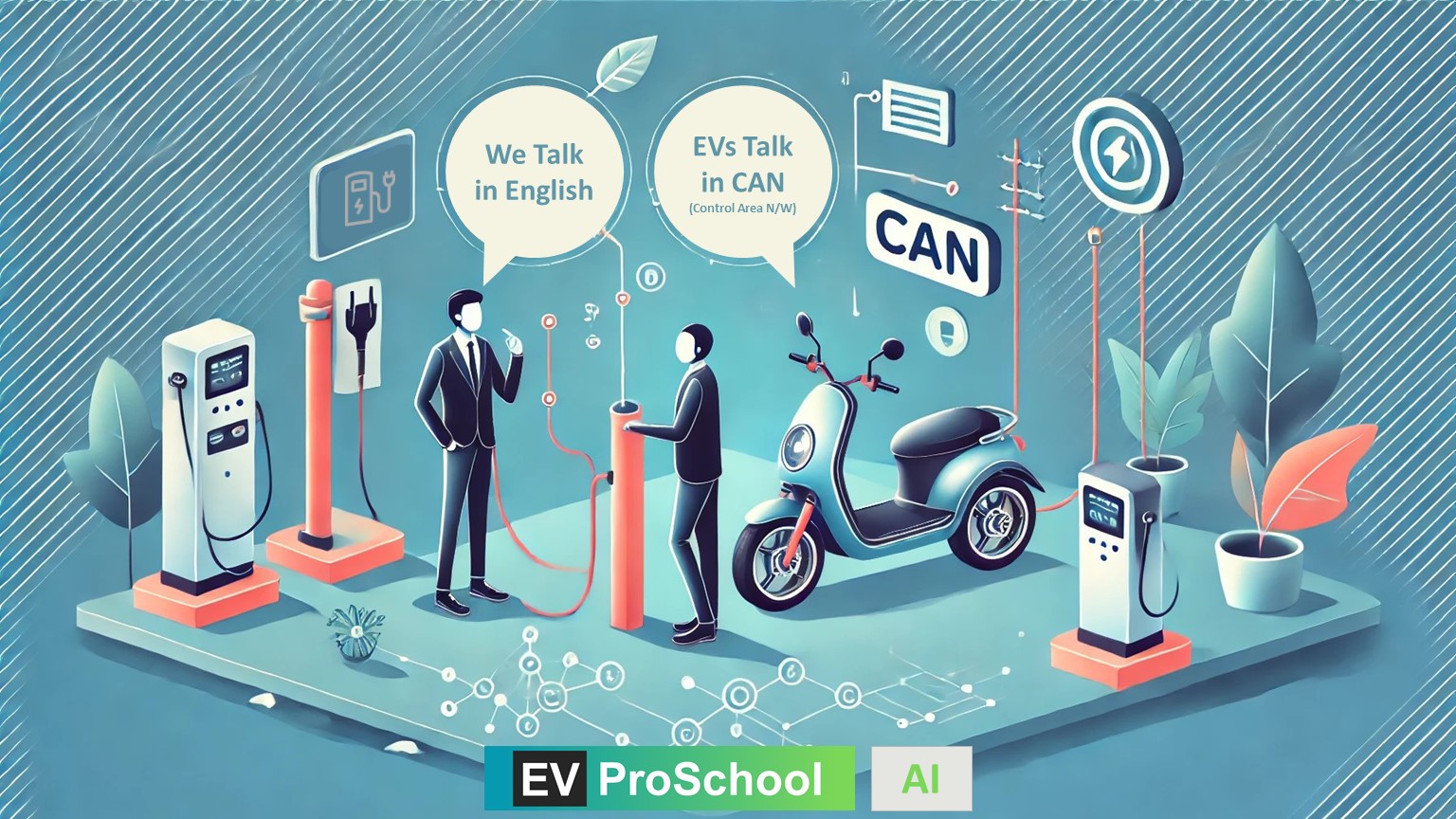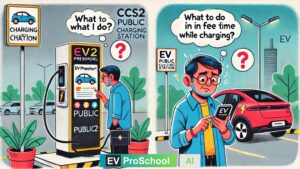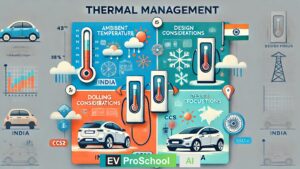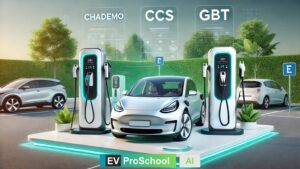Electric two-wheelers (2Ws) are a fast-growing segment in the EV market, known for their affordability, convenience, and eco-friendliness. As EV technology evolves, so does the sophistication of charging infrastructure and communication protocols. For two-wheelers, the interaction between the vehicle and the charging equipment (commonly known as Electric Vehicle Supply Equipment or EVSE) is vital to ensure safe, efficient, and reliable charging. At the core of this interaction lies a robust communication system, with CAN (Controller Area Network) communication playing a pivotal role.
This blog explores how electric two-wheelers and chargers communicate, and why CAN communication has become the go-to standard for 2W charging systems.
1. How Electric Two-Wheelers and Chargers Communicate
Charging an electric vehicle is more than just plugging it in. A two-wheeler and its charger need to exchange data in real time to ensure that the charging process is optimized for safety, battery health, and performance. This is achieved through a combination of physical connections and digital protocols.
A. Physical Connection
- Charging Ports and Plugs: Every electric two-wheeler has a charging port designed to fit specific charger connectors. Depending on the region or manufacturer, standards like Type 2 connectors or proprietary designs are used.
- Pilot Signal Line: A dedicated wire in the charging cable facilitates real-time communication between the charger and the two-wheeler. This enables data exchange about the vehicle’s battery status, charging rate, and safety checks.
B. Digital Protocols
Chargers and vehicles use predefined digital communication protocols to ensure a seamless and safe charging experience. Here’s how the process unfolds:
- Authentication: Before charging begins, the charger verifies whether the two-wheeler is authorized. This could involve user authentication via RFID, a mobile app, or vehicle ID recognition.
- Exchange of Charging Parameters:
- The two-wheeler’s Battery Management System (BMS) shares data like battery voltage, temperature, state of charge (SoC), and required current with the charger.
- The charger adjusts its power output accordingly to deliver the right amount of electricity without overheating or damaging the battery.
- Error Monitoring and Safety Checks:
- Faults like overvoltage, short circuits, or overheating are detected in real-time, and charging is paused or stopped to prevent accidents.
- Charge Completion Notification: When the battery reaches its full capacity, the charger and two-wheeler coordinate to safely terminate the charging process.
C. Advanced Communication Features
Modern chargers and two-wheelers are incorporating advanced communication features such as:
- Smart Charging: Two-wheelers with internet connectivity can coordinate with chargers to start charging during off-peak hours, reducing electricity costs.
- Cloud Connectivity: Data from the charger and vehicle can be sent to the cloud, enabling remote monitoring and diagnostics.
2. Why Two-Wheelers Use CAN Communication for Charging
Among the various communication protocols available, CAN (Controller Area Network) has emerged as the standard for electric two-wheelers. Here’s why it’s so widely used:
A. Reliability in Real-Time Data Exchange
- Critical Data Sharing: During charging, the BMS of the two-wheeler needs to share key parameters such as battery voltage, current, temperature, and SoC with the charger. CAN enables this exchange reliably, ensuring the battery charges safely and efficiently.
- Error Detection: CAN automatically checks for communication errors, minimizing the risk of miscommunication between the charger and the vehicle.
B. Efficiency and Cost-Effectiveness
- Simplified Wiring: A single CAN bus can carry multiple signals, reducing the number of wires needed in the system. This makes it ideal for two-wheelers, where space is limited and cost is a significant factor.
- Optimized for Small Systems: CAN’s design is perfect for the compact systems of electric two-wheelers, ensuring optimal performance without the complexity of advanced protocols like Ethernet.
C. Robust Performance in Harsh Conditions
Two-wheelers often operate in challenging environments, including exposure to extreme temperatures, rain, dust, and vibrations. CAN communication is highly robust and reliable, even in such conditions, ensuring uninterrupted performance.
D. Real-Time Communication
- Dynamic Power Adjustment: During charging, the two-wheeler’s BMS monitors battery health and instructs the charger to adjust power delivery if needed. CAN enables this real-time adjustment, protecting the battery and enhancing its lifespan.
E. Compatibility with Automotive Standards
- Industry Adoption: CAN communication is already widely used in the automotive sector for internal communication between vehicle components. This widespread adoption ensures compatibility and simplifies integration with existing systems.
3. How CAN Communication Works During Charging
Here’s a step-by-step look at how CAN communication supports the charging process in an electric two-wheeler:
- Initialization: When the charger is connected, the two-wheeler’s BMS initiates communication with the charger via the CAN bus.
- Data Exchange:
- The two-wheeler shares its battery’s specifications (e.g., voltage and current requirements).
- The charger responds by delivering power according to the battery’s needs.
- Monitoring: Throughout the charging process, the BMS monitors battery parameters and communicates with the charger to make dynamic adjustments.
- Error Handling: If any fault (like overheating or overvoltage) occurs, the CAN bus ensures that both systems are alerted immediately and charging is halted if necessary.
- Completion: Once the battery is fully charged, the BMS notifies the charger to stop power delivery, ensuring a safe and efficient shutdown.
4. The Future of Communication in EV Charging
As electric two-wheelers become more advanced, CAN communication will likely integrate with emerging technologies such as:
- IoT Connectivity: Enabling chargers and vehicles to interact with cloud-based platforms for smarter energy management.
- Vehicle-to-Grid (V2G) Integration: In the future, two-wheelers may act as energy storage units for the grid, requiring enhanced communication protocols.
While other communication standards like Ethernet or wireless protocols may evolve, the simplicity, reliability, and cost-effectiveness of CAN make it a cornerstone of today’s EV charging systems.
Conclusion
The interaction between electric two-wheelers and chargers is a finely tuned process that ensures safe and efficient charging. By leveraging CAN communication, two-wheelers achieve reliable and real-time data exchange, enabling dynamic power adjustments, fault detection, and optimal battery health.
As electric mobility continues to grow, robust communication protocols like CAN will play a critical role in making charging smarter, safer, and more efficient. Whether you’re an EV enthusiast or a tech-savvy reader, understanding this backbone of EV technology gives you a glimpse into the seamless systems driving the future of transportation



